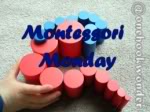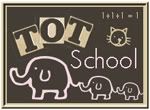I have been asked, more then once, how to help a preschooler get 'ready' to read. I have read other places where the suggestion is to be sure your child knows all her letters, knows her name, and knows a list of basic site words. While these are all GOOD things to know, there are some things that Maria Montessori felt were BETTER things to focus on before 'reading.'
The very first thing to keep in mind as you are reading this, is that you should never push your child to read. With few exceptions, a child will become interested in reading when they are ready. However, there are a few things that you can do while you 'wait' that are fun for both you and your child.
I'm going to give you a peak into what I am doing with Mini Cooper. She is 3 1/2 years old and learning to read is not on her radar. She does, however, enjoy learning, listening to stories, and talking about her letters.
The first goal of the Montessori language lessons is to help a child understand what language is by using it. We expand vocabulary and also bring awareness to the fact that everything has a name. These cards are all photos of things from the bathroom and the kitchen. We discussed what they were, what they did, how we used them, and then Mini sorted them into the correct room.
We play iSpy games. These change as the child grows, but at first we just find objects on the page. Simple questions like-Can you find the flower? or Can you find an animal that quacks?
Matching pictures is another language building exercise. This helps a child become more aware of patterns and similarities-which helps when trying to sound out and read words.
I also choose books that ask questions. This one asks if you can name all the fruits. Well, she COULD name most of them :).
Eventually, a child WILL be interested in learning about their letters. Here is where there becomes a big difference in presentation. While it helps as an older child to know the name of each letter, when you are learning to read it does NOT help to know the name of letter B. It helps to know that B says buh. So, we only teach the letter sounds and not the letter names.

We own the entire set of Jane Belk Moncure's letter sound books. They are EXCELLENT! We started by reading every book in the set, one every day.
In the story, the letter fills a box with items that say her name. I do not use the name of the letter as I read, but the sound the letter makes.
After we got through the set, I have started going back through the alphabet. We read the story, and then go through our picture circles for the letter. Some might use real objects, but my children get VERY distracted by the objects...and they also walk off with them.
The circles, free at The Helpful Garden, have been just what we need.
At the back of each book, there is a picture of all the letters. We go ahead and sing the alphabet song when we are looking at this page. Mini Cooper and Explorer both just LOVE to sing the alphabet song, so I think it's good to do it some. It helps with understanding alphabetical order.
And, here is a peek at our language shelf. To the right are the sound books, to the left are picture books about our current 'theme.' In the middle, are the sandpaper letters. I have not started them with Mini Cooper, yet, but they are there for when she gets interested.
And, while she isn't reading yet, this is how I qualify success for our 'reading' lessons. I often find Mini Cooper surrounded by books 'reading' to herself.
Thanks so much for stopping by!!
God Bless,
Lisa
We're linked up!













This was so useful to read. I'm teaching my two youngest, one is reading the other doesn't know her letters yet; this will be so helpful next year! Thank you!
ReplyDeleteThis post has such important and true information! I don't think a lot of parents realize how important expanding a child's vocabulary is to reading. I love those letter books you have. I definitely need to look into getting some like that.
ReplyDeleteMontessori Education is a precious gift which should be available to all children, everywhere. We know that given a great start, children find ways to learn which are right for them.
ReplyDelete